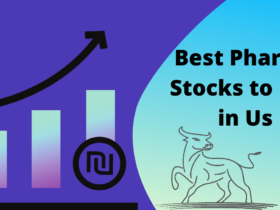Everyone needs healthcare. Or at least they will need it at some point in their lives. And when there is something that everyone needs, there is a huge opportunity for investors.
More than $ 7.8 trillion is spent globally on healthcare. Nearly half of that total – $ 3.5 trillion – is spent in the US growing significantly faster than the overall global economy. With the healthcare sector, these numbers will almost certainly be huge by the end of the decade.
How investors can profit from this growth? Here’s what you need to know about investing in healthcare stocks.
Read Also- Investing in Blue Chip Stocks 2021
Top 5 Best Health Care Stocks
1. Medtronic (ticker: MDT)
The stationary medical devices company Medtronic tops the list first; Claiming more than $ 169 billion and a 43-year streak of rising dividends, MDT is a “set it and forget it” stock. Medtronic managed to make a profit through the epidemic. The stock grew 1.4% in the first quarter and currently pays a 1.8% dividend yield. The trade of Medtronic should be of benefit as the depth of the American epidemic. Sparking the demand for surgery and medical devices that are used in them originates. Medtronic’s investment in surgery with the help of robots still promises to be a long-term driver. As the market is fit to develop in the coming years.
2. CVS Health Corp. (CVS)
Entering 2021, CVS was reputed to be one of the most important points of delivery for the COVID-19 vaccine, and it has not disappointed. By 1 April, the CVS company had administered more than 1 million vaccine doses. With the capacity to rapidly deliver up to 2.5 million vaccine doses per month, anticipating the speed of vaccination in its stores. While the company’s latest quarterly results were achieved, year-over-year net income declined, revenue rose and so was prescription volume. CVS brand loyalty to fiery epidemic consumers, as well as its role as an important player in resolving something new customers should earn. CVS grew by 10.9% in the first quarter and pays a dividend of 2.6%.
3. Zoetis (ZTS)
Although Zoetis was down 4.7% in the first quarter. The industry is a part of it, animal health is still an incredibly important part of the larger sector that should be a risk to all health care investors. Zoetis, which makes products for both companion animals and livestock. Is seeing a surge in demand for its companion animal products and more and more millennials take on pets. Although fourth-quarter revenue increased 8% across the company. Companion animal product sales grew 30% in the United States last quarter and 17% internationally. Zoetis recently received approval for osteoarthritis pain treatment in cats and dogs in the European Union, Brazil, Canada, and Switzerland.
4. DaVita (DVA)
DAVITA is the largest dialysis provider in the US and was an outstanding performer for DVA 2021 in 2020. Growing by 55% to buy repetition pickups from the best healthcare Technology stocks. But the stock price slipped 8.2% in the first quarter of 2021 DAVITA’s valuation remains attractive. With the stock trading for just 17 times earnings, and analysts expect fairly impressive earnings per share growth of around 14% over the next five years. The greatest investor ever, Warren Buffett, also believes in DAVITA, with his financial holding company Berkshire Hathaway (BRK.B, BRK.A) owning a huge 33% stake in a Denver-based business.
5. AbbVie (ABBV)
Big Pharma giant AbbVie is another of the best health care stocks to buy for 2021, and shares of the company, worth more than $ 190 billion, rose 2.2% in the first quarter. AbbVie owns the world’s most successful commercial drug. Curing a number of diseases, from immunosuppressive arthritis to plaque psoriasis, Crohn’s disease, and more. It is also coming off its 2020 acquisition of Allergan, the company behind Botox, which is its own well-established, long-term anti-wrinkle drug. ABBV shares a healthy 4.8% dividend, the highest payout on this list, and is a dividend rich to boot, raising its dividend payout for 49 years straight. ABBV also looks like a solid value stock, trading for at least eight times further earnings.
Different types of healthcare stocks
The healthcare sector is so broad that there are several different kinds of healthcare stocks. Four of the most important types of healthcare stocks are:
- Drug stocks: Drugmakers focus on the development of drugs to treat diseases. Biotechs, using organisms to survive such as bacteria or enzymes to develop drugs while pharmaceutical companies to develop drugs using chemicals. Every year sales with no products at drug stocks market yet from large companies with small biotechs billions of dollars.
- Medical device stocks: Medical device companies are devices that are used in the care of patients. These devices, such as disposable gloves and thermometer, is too complex to simple, from to, artificial heart valves, and robotic surgical systems.
- Payer stocks: Donors, including health insurers and pharmacy benefit managers (PBMs), the American health care system plays a particularly important role. Insurance companies, healthcare charging premiums for individuals and employers to pay for the cost while PBMs employers and authorities to ensure that prescription drugs to health plans.
- Healthcare provider stocks: Patients to health care providers stand distribution frontline health services. They include hospitals, physician practices, home health companies, and long-term care (LTC).
What to look for in healthcare stocks
1. Growth prospects
The most important thing you want to check with any health stock you are considering is the growth prospects of the company. See how quickly the company’s earnings have increased in recent years. The future is not always a mirror of the past, but if a company has not been able to deliver strong revenue growth. It probably will not be able to do so by moving forward.
Read the investor presentations of companies on their websites to find out what their strategy is for development and how big they think their potential market is. Check out the competitors of the companies to see if their strategies look just as good or even better. By the way, companies will often mention specific competitors by name in their 10-year annual regulatory filings for the US Securities and Exchange Commission (SEC).
2. Financial strength
Regulatory filings for the SEC can also help with financial statements that include an assessment of a company’s financial strength. Ideally, a company would already be profitable. If it is not, then you learn how to make sure the company plans to achieve profitability and how soon it is expected to do the same.
A company’s cash position, which includes cash, cash equivalents, and short-term investments. Can be found on the balance sheet in its annual and quarterly regulatory filings (a financial statement that lists the company’s assets, liabilities, and shareholders equity).
Another important gauge free cash flow of financial strength (FCF) that generates a company. FCF measures left after paying for the cash operating costs and capital expenditures (money spent on things like buildings, equipment, and land). As is the case with the cash position, the high FCF of a company strengthens its financial position.
3. Valuation
You would like to know how much it is worth before buying a new car. Determining the valuation of a health care stock before purchasing so you can really pay a fair price for it is also important.
Quite a few evaluation matrices can be used. You get every dollar you earn for your investment – the most popular one-price-to-earnings (P / E) ratio, which measures the price of a share in relation to its earnings per share.
Some P / E ratios are backward-looking, reflecting earnings over a prior period of time (typically the last 12 months).
4. Dividends
Some healthcare shares pay dividends – a portion of the company’s return income to shareholders. Dividends can increase the total return you receive from the owner of a share.
The dividend yield tells you how much a share’s annual dividend payments are as a percentage of the current share price. The stock has a payout ratio, which is a dividend as a percentage of earnings. And indicates how much of the company’s cash is being considered to cover the dividend.








